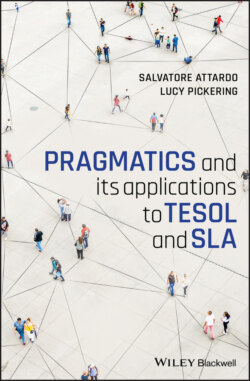Читать книгу Pragmatics and its Applications to TESOL and SLA - Salvatore Attardo - Страница 27
2.4 Is There a Developmental Path for Pragmatics?
ОглавлениеThe gold standard for describing a possible developmental path in pragmatic competence is longitudinal data. Perhaps the most famous early study of this nature is Schmidt (1983) who undertook a three-year study of Wes, a 33-year-old native speaker of Japanese. Schmidt focused on Wes’s development of directives (a set of speech acts that includes orders, requests, and suggestions). Initially Wes relied heavily on formulaic utterances or fixed expressions (e.g., I’ll have X, Can I have X, Shall we X). As his language developed, one way in which it showed was an elaboration of these initial patterns, for example, OK, if you have time please send two handbag, but if you’re too busy, forget it (p. 154), and he was also more confident in producing face-threatening acts such as complaints, for example, excuse me, this milk is no good, sour I think (p. 154). However, issues remained when he began parsing out these formulaic phrases that then led to problematic utterances, for example, if you back to room, can I bring cigarette? (“please bring me a cigarette”) (p. 155). Although longitudinal studies continue to be rare in comparison to cross-sectional research, more recent studies have agreed with Schmidt’s original findings that learners initially stick to routinized utterances and unanalyzed chunks to express meaning (Taguchi, 2010).
With regard to request development specifically, Kasper and Rose (2002) compiled the results of studies to suggest a five-stage development of requests that expands from a formulaic stage to a gradual “pragmatic expansion” in which new forms are added and more complex linguistic patterns are employed and expanded beyond a one-to-one mapping between specific forms and specific functions. Although it is unclear precisely how grammatical and pragmatic competence map onto each other, it seems clear that a certain level of grammatical competence is required (although that can vary considerably, see Bardovi-Harlig, 2013; Yang, 2016). Focusing again on request strategies, Cook and Liddicoat (2002) used a multiple choice questionnaire to assess low- and high-proficiency learners’ interpretation of direct and indirect requests. There was a significant difference between the two groups of learners in their ability to process the context and form of indirect requests, and lower proficiency learners relied more heavily on linguistic knowledge (i.e., bottom-up linguistic knowledge) to interpret the requests. That said, the converse does not appear to be true: a higher level of grammatical competence does not guarantee an equally high level of pragmatic competence (Bardovi-Harlig & Mahan-Taylor, 2003; Mirzaei & Esmaeili, 2013). This is particularly the case with pragmatic areas other than speech acts. Exposure to nonliteral meaning such as implicature, for example, has not been shown to necessarily enhance acquisition of this pragmatic concept (Bouton, 1994). We will come back to this in Chapter 4.
Other areas of pragmatic development that have been investigated, beyond speech acts, include a variety of conversational features including adjacency pairs (see Section 8.1.2), topic management, and interactional markers. For example, in a relatively early longitudinal study of interactional markers, Sawyer (1992) traced the development of the Japanese sentence-final particle ne by JSL learners over one year in an immersion environment through semi-structured interviews. Ne is described as a sentence final particle that indicates very generally a seeking of confirmation from the hearer or a rapport marker signaling expectation of common ground. As with other pragmatic phenomena, it always occurred initially as part of fixed phrases learned as formulaic chunks. However, it was developed later and more inconsistently than other vocabulary items and the success of individual acquisition varied widely. We look more closely at interactional markers in Section 7.3.
A final area to be considered here is the impact of context of use in the development of pragmatics. Traditionally, this has been defined as the difference between ESL and EFL contexts (Rose, 1994); however, more recently it encompasses the manifestation of pragmatic phenomena in English as a Lingua Franca (House, 2010) and the pragmatic development of third-language or plurilingual users (Jordà, 2005). We will come to this in Chapter 11.
